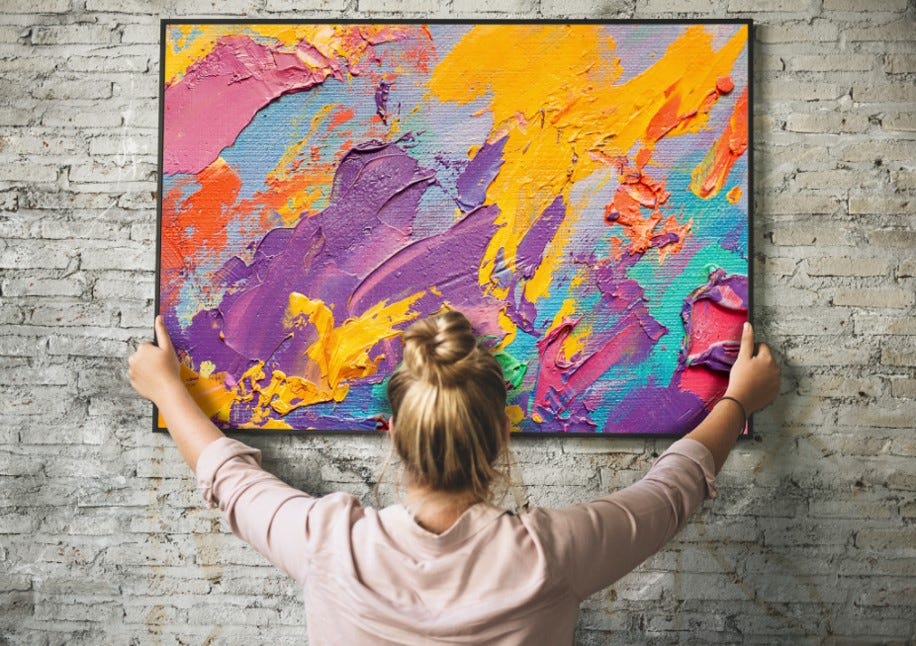Framing doesn’t just show off your best work, it also protects your works from damage, mould and moisture. So, with this frame of mind, show off your next masterpiece with these tips for framing your own artworks.
Store watercolours and gouache safely before framing

Before you frame your own artwork, you’ll want to store your watercolours and gouache works in a safe, dry place (especially gouache because any moisture can run the risk of the gouache returning to its water state). So in between finding the perfect frame for your works, you’ll need to store them safely. Lay them flat in a drawer or a portfolio case and use acid-free tissue or wax paper to make sure the sheets don’t rub against one another.
Use a fixative for an easy fix

It’s no secret that charcoal, pastel and chalk works can be easily smudged. So, before you frame your own artworks, use a fixative to stop any loose dust or pigment from building up on the glass behind the frame. A fixative will provide an added protective coat and stop any pigment build up. Spray your fixative at around 30cm away from the work and keep your arm moving to avoid any build up. If you haven’t used a fixative before, try spraying it on a sheet of scrap paper first to find the right amount of spritz, and don’t spray a lot in one place.
Use mat boards

Your artwork will need to be framed behind glass to protect it, especially for delicates like watercolours and drawings. It’s ideal to mount the work behind a mount board or mat board, not only because it will generally look better, but a mat, along with a glass protective sheet will also stop watercolour and gouaches from rubbing on the inside of the glass, so you can frame it, hang it and not have to spend time cleaning it.
Look for museum quality or acid free mat boards

Mat boards (think of them as the backing board) come in a variety of colours, sizes and textures but if you’re not going to a professional framer and you want to protect your works, then look for a museum-grade mat board or a board that’s acid free. This is because cheaper alternatives are usually made from cheaper materials and overtime, these boards can yellow and damage works on paper like drawings.
Use a thin frame for delicates and a large for abstracts

Clearly when it comes to framing your own artworks it’s all about personal choice. You might like lots of matting against a thin, delicate frame, or you might prefer less matting against a wider frame.
Traditionally, delicate drawings and watercolours use a large matting board and a thin delicate frame, while an abstract work, typically looks better with a plain, box frame and less matting to show off the work. You don’t need to frame acrylics on canvas, but if you have an acrylic work on paper, you can frame your art behind glass.
Skip the oils

Because oil paints take a long time to fully dry and cure (from 6 -12 months), you can skip the frame and reach for a good quality varnish instead. Wait 6 months for the oil to cure and dry before varnishing with a wide, soft taklon brush to protect it and reduce the risk of any oil cracking.
Hang your works at eye level

Of course, all buildings, ceilings and personal taste are different, but the general rule is to hang your artworks so that the middle of the work is at eye level. Keep them out of direct sunlight and away from areas that will likely attract moisture, like a bathroom. If you’re working with a few artworks, hang them in a line and hang them all level with each other at the top, making sure that the space between each one is the same. For more on lighting, and hardware check out our article how to best display your work.
Use cardboard sleeves when transporting artworks

You’ll notice picture frames and store-bought frames always come with cardboard sleeves on the corners, that’s because they stop the frames from rubbing on one another. If you buy a store-bought frame, you might want to keep these for transporting artworks. Otherwise, bubble wrap and foam can help to stop frames rubbing against each other.
So whether you choose a large, elegant frame, a small delicate frame or something in between, the choice is yours and we hope that you feel inspired to create your own masterpiece.
Show us how you frame your own artworks and #montmarteart or tag us @montmarteart on Instagram or Facebook, we’d love to see what you come up with.





























